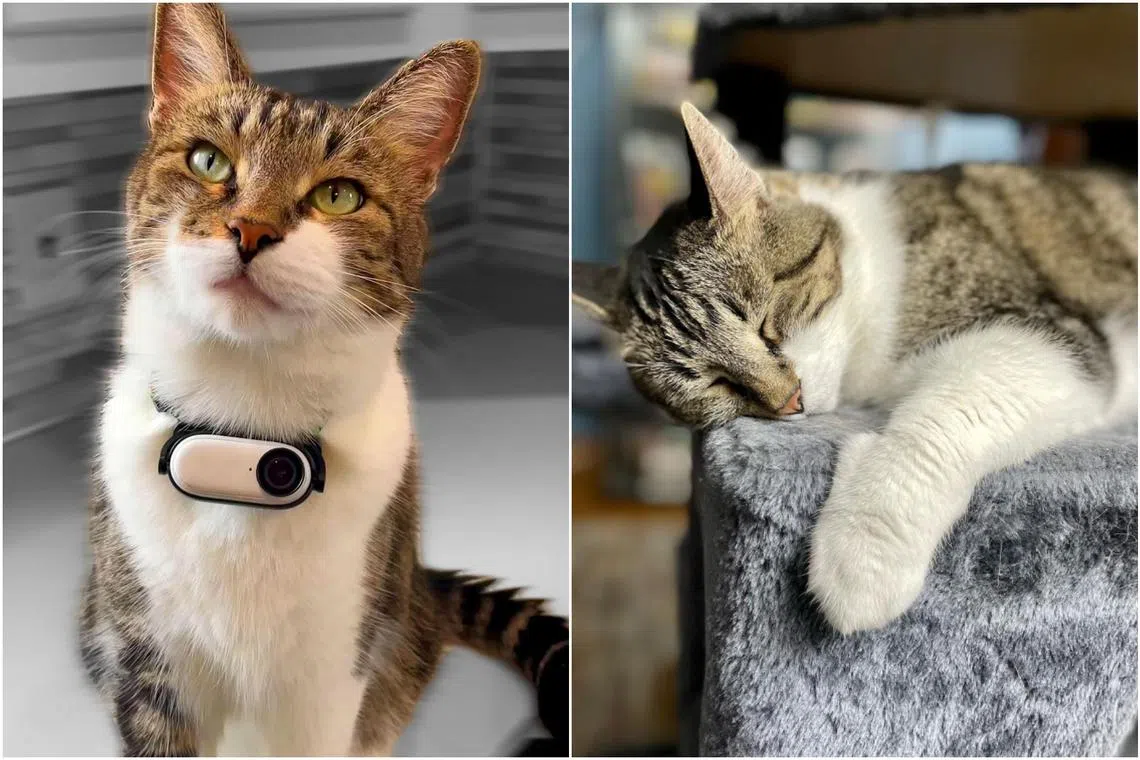These cats film their own stunts
Sign up now: Get ST's newsletters delivered to your inbox

Mr Kitters has 1.5 million followers on TikTok and nearly one million on Instagram, where viewers can watch him meow at a bird or chase a squirrel.
PHOTO: MR.KITTERS.THE.CAT/INSTAGRAM
Follow topic:
UNITED STATES – In one video, the athlete pauses, assesses the height and leaps. He tries to free-climb up the side of a building before jumping back to the ground. In another, he leaps across a roof, his shadow stretching out long in front of him.
This gymnast is a cat. Specifically, he is Gonzo of @gonzoisacat.
Gonzo is the star, and the director, of his own shorts. Rather than his owners filming his stunts, Gonzo can capture them with the help of a tiny camera attached to his collar. The result is an extreme sports cinema verite-style documentary from a cat’s perspective. And it is catching on online.
In Norway, a GoPro-wearing cat roams snowy meadows or climbs on a roof. One in China also records under-the-chin videos. Another catfluencer named Mr Kitters has 1.5 million followers on TikTok and nearly one million on Instagram, where viewers can watch him meow at a bird or chase a squirrel.
“The cat goes out there, and it’s like, ‘What is he doing, out in the world?’” said documentary film-maker Derek Boonstra, 40, who cares for Gonzo with his wife in Los Angeles.
The couple decided to start filming Gonzo about four years ago. They wondered what he was doing when no one was watching and wanted to make sure he was safe when he was exploring outside. After experimenting with a do-it-yourself camera, Boonstra bought one from the brand Insta360. In exchange for two more free ones, he said, he tags the camera company in his videos.
The first day they filmed about “90 minutes of him sleeping in a bush”, said Boonstra, who has a tattoo of the cat.
But then Gonzo ran into some baby opossums. “That was immediately, like, ‘this is really fascinating’,” he said.
Cats are among the earliest and most constant staples of entertainment online. Jason Eppink, an artist who curated an exhibition about cats on the Internet at the Museum of the Moving Image in 2015, broke down online cats into three main eras.
When YouTube and message boards were dominant, cat clips looked a lot like America’s Funniest Home Videos – they were a little grainy and amateurish.
“There wasn’t this cat industrial complex yet,” said Eppink.
Then, as Facebook took hold, the cats became memes. Silly-looking celebrity cats, such as Lil Bub or Grumpy Cat, rose with Instagram and the early influencer Internet.
The rise of wearable camera technology, though more often used by surfers or snowboarders than pets, has led to another niche style of cat content. Like viewers of extreme sports videos, cat video fans regularly note the thrill they feel when their feline stars leap or scamper.
“A lot of the comments are, ‘I kind of wish I were a cat,’” said Mr Scott Irwin, who runs Mr Kitters’ social media accounts. “It’s a way for them to escape for 15 seconds at a time.”
Mr Kitters, who lives in Indiana, does more sponsored content, posting videos about a pet-grooming vacuum or the camera itself. He started the accounts in August and has received some free cat-related products too.
In February, Mr Kitters made about US$8,000 (S$10,600) through TikTok and partnerships with Pretty Litter and the video game Genshin Impact, said Mr Irwin, 58.
Mr Kitters is his 20-year-old daughter Lucy’s cat. They have six other cats too. The father and daughter used to send each other cat videos on TikTok as a way to bond. When he saw Gonzo’s videos, Mr Irwin bought one of the cameras for himself. Initially, he thought of the footage as a “photo album”, he said.
Mr Kitters became a celebrity almost within a week. Mr Irwin started tagging Insta360, which gave him two free cameras, he said. He also earns a small commission if someone purchases a camera through his link.
Fans love Mr Kitters for his chatter and chirps, sounds that people usually associate only with human interactions.
That might be the real draw of these videos: Cats are enigmas. Humans rely on a slim codex of tail flicks and meows to read their emotions. In part, that is because of the history of domestication, said Dr Mikel Delgado, a cat behaviour expert at Feline Minds. Humans have been living alongside dogs for longer than cats, she said, and we often project human mannerisms onto them.
“Cats have fewer facial muscles, so people have a harder time reading cats,” said Dr Delgado.
Outdoor cats also spur curiosity, said University of Pennsylvania School of Veterinary Medicine’s animal welfare Emeritus Professor James Serpell. The videos reveal a hidden side of cat behaviour, one unmediated by a human presence. “People may get a vicarious thrill from following the adventures of their cat,” he said.
Lots of the footage can be boring nonetheless, Mr Irwin said. After all, most cats spend a majority of their days napping or sitting. But “every once in a while, you get that 15 seconds of gold”.
Still, there is something strange about the way that Mr Kitters’ fans expect him to be, well, human. Some of them ask for specific interactions, such as seeing him climb a tree, which baffles Mr Irwin.
“I can’t make him do anything like that,” he says with a laugh. “I’m not doing anything but posting the videos that he’s filming and directing.” NYTIMES

